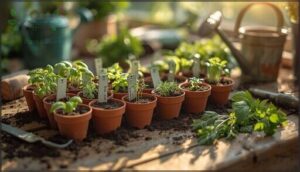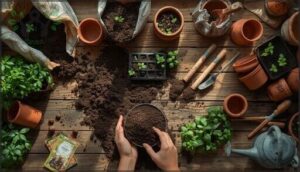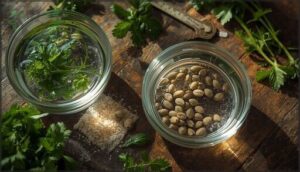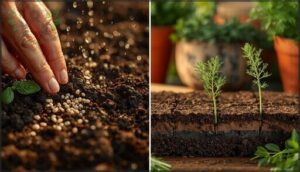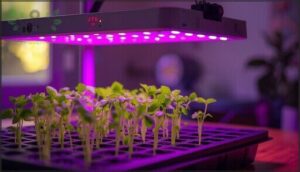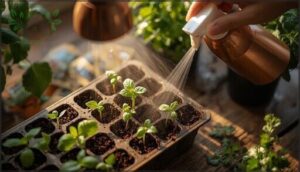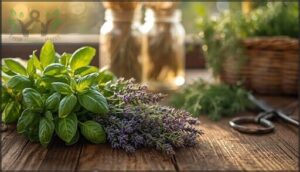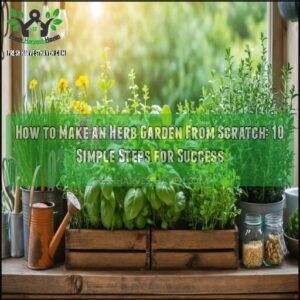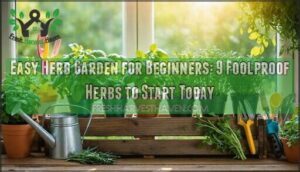This site is supported by our readers. We may earn a commission, at no cost to you, if you purchase through links.

A single packet of basil seeds costs less than a dollar and yields enough plants to keep your kitchen stocked all summer long—that’s roughly fifty times cheaper than buying starter plants. Growing herbs from seed isn’t just economical, though. It provides access to heirloom varieties and specialty herbs you won’t find at any garden center, from lemon basil to pineapple sage.
You’ll also gain complete control over your plants’ health from day one, ensuring they’re grown in clean soil without mystery chemicals.
Starting an herb garden from seed does require patience and attention during those first few weeks, but the process is surprisingly straightforward once you understand the basics of timing, soil preparation, and seedling care.
Table Of Contents
- Key Takeaways
- Why Grow Herbs From Seed?
- Which Herbs Are Easiest to Grow From Seed?
- When and Where to Start Herb Seeds
- Preparing Soil and Containers for Herb Seeds
- Step-by-Step Guide to Sowing Herb Seeds
- Caring for Herb Seedlings and Young Plants
- Harvesting and Preserving Your Homegrown Herbs
- Frequently Asked Questions (FAQs)
- How do you grow herbs from seeds?
- Can you start a herb garden from seed?
- What do you need to grow a herb garden?
- How do you start a herb garden?
- How do I choose a place to grow a herb garden?
- How to grow a Herb Garden Indoors?
- How to start an herb garden from seeds?
- Do you need to soak herb seeds before planting?
- Can I just throw herb seeds on the ground?
- How do you grow a herb garden?
- Conclusion
Key Takeaways
- Growing herbs from seed costs roughly fifty times less than buying starter plants while giving you access to heirloom varieties and specialty herbs you won’t find at garden centers, plus complete control over soil quality from day one.
- Annual herbs like basil, dill, and cilantro are the most forgiving for beginners with 85-95% germination rates and fast maturity (40-70 days), while perennials like thyme and oregano take longer to establish but reward you with 4-8 seasons of harvests.
- Success hinges on nailing the basics: sterile soil with proper drainage, 6-8 hours of light daily (or grow lights positioned 6-12 inches above seedlings), temperatures between 65-75°F, and careful moisture management to prevent damping off disease.
- Start seeds indoors 6-8 weeks before your last frost date, harden off seedlings gradually over 7-14 days before transplanting, and harvest mid-morning before flowering begins to capture peak flavor when essential oils are most concentrated.
Why Grow Herbs From Seed?
You might be wondering if it’s worth the extra effort to start your herbs from seed instead of picking up plants at the nursery. The truth is, growing from seed offers some real advantages that go beyond just saving a few dollars.
Let’s look at why so many gardeners choose to start their herb gardens this way.
Benefits of Starting Herbs From Seed
Starting herbs from seed unlocks plant diversity you won’t find at nurseries, letting you explore unique varieties suited to your cooking style. You’ll enjoy cost effectiveness, spending pennies instead of dollars per plant.
Seed starting gives you control over growth conditions from day one, promoting stronger plant health and natural adaptation to your garden. Plus, there’s a real educational benefit in watching seeds transform into thriving herbs—it’s gardening at its most rewarding.
Using sterile potting soil can help you avoid potential contamination.
Cost Savings and Variety
Beyond the hands-on benefits, growing herbs from seed delivers serious budget wins. Seed packets cost $0.50 to $2.00 versus $2.00 to $5.00 per seedling—that’s pennies per plant when you’re choosing herb seeds. Bulk seed discounts stretch your dollar further, and seed saving benefits mean you’ll replant next season for free.
Plus, heirloom herb types and experimental herb growing options expand your culinary palette beyond what nurseries stock. This method also allows for better control over growing conditions.
Control Over Germination and Growth Conditions
When you start herbs from seed, you’re in charge of every step. That means dialing in germination conditions like temperature control (65-75°F is ideal), moisture levels, and the light spectrum your seedlings need. You’ll manage air circulation for disease prevention, maintain soil moisture without waterlogging, and create prime growing conditions from day one.
- Temperature control: Use heat mats to speed germination and boost success rates.
- Light spectrum: Red and blue wavelengths support strong seedling development.
- Moisture levels: Keep soil consistently damp, not soaked, to prevent rot.
- Air circulation: Good airflow stops damping off and fungal problems before they start.
Which Herbs Are Easiest to Grow From Seed?
Not all herbs are created equal with respect to starting from seed. Some sprout quickly and tolerate beginner mistakes, while others demand more patience and precision. Let’s break down which herbs will give you the best shot at success, whether you’re after annuals for a single season, perennials that return year after year, or varieties that match what you actually cook with.
Best Annual Herbs to Start From Seed
Annual herbs like basil, dill, and cilantro are your best friends for seed starting—they’re forgiving, fast, and rewarding. Basil boasts 85–95% seed germination and matures in 60–70 days, while dill reaches harvest size in just 40–50 days.
When selecting herb seeds, look for varieties suited to your growing conditions. These annuals thrive with basic soil preparation and deliver abundant harvests, making seed germination practically foolproof for beginners growing herbs from seed.
Perennial and Biennial Herb Options
If you want herbs that come back year after year, perennial choices like thyme, sage, and oregano are worth the wait—most perennial seeds take 14–21 days to germinate but reward you with 4–8 seasons of harvests. Biennial options include parsley and caraway, which produce leaves the first year and seeds the second.
Garden planning matters—perennials need permanent spots, while biennials rotate out after flowering.
- Lavender and rosemary thrive in zones 5–9 with proper drainage
- Lemon balm yields multiple harvests annually across five-plus seasons
- Caraway seeds require stratification for best germination
Choosing Herbs Based on Your Cooking Needs
Think about the dishes you cook most often—that’s where flavor profiles guide smart herb choices. If Mediterranean cuisine fills your table, prioritize basil, oregano, and thyme seeds for recipe versatility. Mexican cooking? Cilantro becomes essential.
Choosing herbs to grow means matching culinary herbs to your actual meals, ensuring seasonal availability and natural herb substitutions when one variety runs low.
When and Where to Start Herb Seeds
Timing and location can make or break your herb-growing success, so it’s worth getting these basics right from the start. You’ll need to decide whether to start seeds indoors under lights or sow them directly outside, and whether containers, raised beds, or garden plots work best for your space.
Let’s walk through the key considerations that’ll set your herbs up for healthy, vigorous growth.
Timing for Starting Herb Seeds Indoors and Outdoors
Timing your seed starting hinges on frost dates and growing season length in your climate zone. Most herbs should be started indoors six to eight weeks before your last expected frost, usually March through early April in temperate areas.
For outdoor sowing times, wait until soil warms to at least 50°F for cool-season herbs or 65°F for warmth-lovers like basil, ensuring proper germination windows and strong starts.
Deciding Between Containers, Raised Beds, or Garden Plots
Your growing space dictates your setup more than you might think. Space limitations, budget considerations, and accessibility needs all play key roles in this decision.
- Containers shine for renters or small patios, offering portability and excellent soil control—though you’ll water more frequently
- Raised gardens warm up faster in spring (up to 2 weeks earlier) and reduce bending, perfect for accessibility needs
- Garden plots accommodate larger herb collections but demand more soil prep and weeding effort
Container gardening works beautifully when aesthetic preferences matter, too.
Creating The Ideal Growing Environment for Herbs
Success hinges on nailing the fundamentals: Light Requirements and Temperature Control make or break seedling development. Most herbs demand 6-8 hours of full sunlight daily, while indoor setups need grow lights positioned 6-12 inches above seedlings.
Maintain daytime temperatures between 65-70°F with adequate drainage and proper Air Circulation.
Monitor soil moisture religiously—Moisture Management prevents damping off while ensuring steady growth under ideal growing conditions.
Preparing Soil and Containers for Herb Seeds
Getting your soil and containers right from the start makes all the difference in how your herb seeds germinate and grow. Think of it as building the foundation for a house—you wouldn’t skimp on that, and you shouldn’t skimp here either.
Soil and container preparation is the foundation of successful herb seed germination—don’t skimp on the basics
Let’s walk through the essentials you’ll need to set your seeds up for success.
Choosing The Right Soil Mix for Herbs
You want your herb seeds to feel right at home, so start with a sterile, fine-textured soil mixture. Aim for a soil pH between 6.0 and 7.0—that sweet spot helps nutrients flow easily.
Drainage needs are huge; mix in perlite or bark fines to keep roots happy, not soggy. Good aeration and proper soil texture make all the difference in germination success.
Amending Soil With Compost or Fertilizer
Once your soil mix is ready, you’ll boost it with compost or organic fertilizer to feed those seeds. Spread 3 to 6 inches of compost and work it into the top 6 to 8 inches of soil—this builds organic matter and balances microbial activity.
Consider these benefits:
- Improved moisture retention during dry spells
- Enhanced nutrient availability through beneficial microbes
- Better soil structure and aeration for roots
- Reduced need for synthetic fertilizers
- Slow, steady nutrient release preventing stress
Organic material aids Soil pH Management naturally, while compost tea benefits include active enzymes that help young herbs thrive. Choose fertilizer ratios like 11-11-40 if you need quick nutrients, but remember that organic approaches build lasting soil health without salt buildup.
Selecting Proper Containers and Ensuring Drainage
After enriching your soil, pick containers wisely—material matters. Terra cotta pots breathe well, preventing root rot, while plastic retains moisture longer for thirsty herbs.
Aim for 12-inch pots holding 3.5 gallons for three to four plants. Drill drainage holes every 3 to 4 inches along the base, then place outdoor containers where water flows freely away from roots.
Step-by-Step Guide to Sowing Herb Seeds
Now that your soil and containers are ready, it’s time to put those seeds in the ground. Sowing herbs correctly from the start makes all the difference in how well they germinate and grow.
Let’s walk through the key steps that’ll help you get those tiny seeds off to a strong, healthy start.
Soaking and Prepping Seeds for Better Germination
Prepping your seeds before planting can dramatically improve germination rates and give your herbs a head start. Soaking benefits include softer seed coats and faster sprouting—sometimes up to four days earlier.
Here’s how to prep different seed varieties:
- Soak larger herb seeds like parsley for 8-12 hours in lukewarm water
- Keep small seeds like basil to just 4-6 hours to prevent waterlogging
- Try scarification methods (light sanding) on tough-coated seeds before soaking
- Maintain temperature control around 70-75°F during the seed germination process for best results
Planting Techniques for Tiny and Large Seeds
Once your seeds are prepped, planting technique makes all the difference. Seed depth matters—tiny seeds like basil need light exposure for germination, so press them lightly into soil without burying them. Large seeds like dill should go about an inch deep for proper soil contact.
| Seed Size | Seed Depth | Sowing Method |
|---|---|---|
| Tiny (basil, thyme) | Surface to 1/8″ | Press gently, mix with sand |
| Medium (cilantro) | 1/4″ to 1/2″ | Light soil coverage |
| Large (dill, parsley) | 1/2″ to 1″ | Individual planting holes |
| Broadcasting | Varies | Best for large seeds only |
Watering needs vary too—mist tiny seeds to avoid washing them away, while larger ones handle gentle watering better. Seed thinning comes later when you’ve got two sets of true leaves, giving your strongest seedlings room to thrive without competition.
Using Grow Lights and Ensuring Adequate Light
Without proper lighting, your herb seedlings won’t reach their full potential—photoperiod effects and light intensity matter just as much as water and soil. Growing herbs from seed indoors means you’ll need LED placement close to seedlings, ideally 4–6 inches above them.
- Provide 10–12 hours of light daily for most herbs during seed starting
- Use LED grow lights with 5,000K–7,000K spectrum for energy efficiency and compact seedling morphology
- Position growing lamps to deliver at least 350 μmol/m²/s light intensity
- Supplement natural light from south-facing windows during shorter days
- Monitor seedlings for stretching—a sign your light requirements aren’t being met
Adequate light prevents leggy growth and builds stronger transplants for your garden.
Preventing Damping Off and Promoting Airflow
Because damping off strikes fast in humid, crowded conditions, you’ll need to stay vigilant during germination. Start with soil sterilization using fresh seed starting mix, never reused potting soil.
Practice bottom watering to keep foliage dry, and maintain proper seed spacing to avoid overcrowding. Fan usage improves airflow around seedlings, while humidity control—reducing moisture as plants emerge—stops fungal pathogens before they spread.
Caring for Herb Seedlings and Young Plants
Once your herb seeds have sprouted, the real work begins—but don’t worry, it’s easier than you think. Getting seedlings from that delicate first-leaf stage to strong, transplant-ready plants requires some attention to watering, light, and timing.
Here’s what you need to know to keep your young herbs thriving and ready for the garden.
Watering and Fertilizing Seedlings Properly
Think of seedling care like Goldilocks searching for “just right”—too much water drowns roots, too little stunts growth. Watering frequency depends on your conditions, but aim for moist soil, not soggy. Check the top two inches; if they’re dry, it’s time.
Once true leaves appear, start fertilizing with diluted, balanced liquid fertilizer twice weekly to support healthy development without overwhelming young plants.
Thinning and Transplanting Herb Seedlings
Crowded seedlings won’t reach their full potential—they battle each other for light, water, and nutrients. That’s why thinning seedlings when they’re 2-3 inches tall improves root development and growth vigor. Snip weaker plants at soil level to avoid disturbing neighbors.
When seedlings develop true leaves, you can begin transplanting seedlings into larger containers. Handle roots gently, reduce seedling density, and watch thinning benefits unfold through stronger, healthier plants.
Hardening Off Seedlings for Outdoor Planting
Seedlings raised indoors need gradual exposure to outdoor gardening conditions—a process called hardening off seedlings that prevents transplant shock. Start your acclimation duration 7-14 days before transplanting, placing seedlings outside for 1-2 hours in filtered light. Watch weather conditions closely, avoiding frost and harsh winds during seedling preparation.
Best practices for hardening off seedlings:
- Increase outdoor time by 1-2 hours daily, strengthening stems against wind
- Begin in sheltered spots with mild temperatures between 60-75°F
- Water from the base to prevent leaf burn during adjustment
- Bring seedlings indoors if nighttime temperatures drop near frost levels
- Monitor for wilting or yellowing—signs you’re pushing too fast
Managing Pests and Common Seedling Issues
Even healthy seedlings face threats from aphids, fungus gnats, and damping off—diseases that account for nearly 90% of early-stage losses.
Scout your trays weekly for pests like whiteflies or yellowing leaves signaling nutrient deficiency.
Prevention beats cure: use sticky cards for pest identification, guarantee good airflow for disease prevention, and apply neem-based organic control when needed. Integrated management keeps problems manageable without harsh chemicals.
Harvesting and Preserving Your Homegrown Herbs
You’ve put in the work to grow your herbs from seed, and now comes the fun part—actually using them. Knowing when to snip, how much to take, and the best ways to preserve your harvest will keep you stocked with flavor all year long.
Let’s look at how to get the most out of your homegrown herbs, from the first harvest to long-term storage.
When and How to Harvest for Best Flavor
Fortunately, ideal timing makes all the difference when you harvest herbs for maximum flavor. Head out mid-morning, once the dew dries but before the day heats up—that’s when oil concentration peaks in your fresh herbs.
For the best results from your herb garden, remember:
- Harvest before flowering starts, as leaf quality declines once blooms appear
- Take up to 75% of current growth without harming the plant
- Stop harvesting culinary herbs about a month before frost for perennials
- Handle gently to minimize damage during post-harvest care
- Avoid harvesting immediately after watering or rain
The harvest quantity you gather depends on your plant’s maturity and the season ahead.
Pruning Techniques to Encourage Growth
Smart pruning techniques can boost your herb yield by up to 50%, turning modest plants into productive powerhouses. Always cut at a node—where leaves meet the stem—using sharp, clean shears to encourage bushier growth.
Pinching back fast growers like basil prevents premature flowering and keeps flavor strong.
Regular pruning also improves air circulation, reducing disease risk while redirecting energy toward fresh, harvestable growth.
Drying, Freezing, and Storing Herbs for Later Use
After harvesting and storing herbs through smart pruning, you’ll want to preserve that bounty. Drying techniques work beautifully for woody herbs like rosemary—hang bundles in a dark, airy spot or use a dehydrator at 95°F to retain nutrients.
Freezing methods suit tender herbs like basil; chop and freeze in olive oil for easy use.
Properly dried herbs maintain flavor for months, extending the herb harvest well beyond the growing season.
Frequently Asked Questions (FAQs)
How do you grow herbs from seeds?
Growing herbs from seeds demands attention to seed viability, proper planting depth, and soil pH balance. You’ll need consistent light duration during germination, careful monitoring of the seed germination process, and vigilance against common diseases threatening young seedlings.
Can you start a herb garden from seed?
Yes, starting herbs from seeds is absolutely possible and quite rewarding. With proper seed viability testing and germination troubleshooting, you’ll find seed starting success comes naturally, even for beginners exploring herb garden basics.
What do you need to grow a herb garden?
Think of your herb garden as a recipe—you’ll need quality seeds, well-draining soil, containers with drainage holes, adequate sunlight (at least six hours daily), consistent watering techniques, and basic seed starting equipment like grow lights.
How do you start a herb garden?
Starting herbs from seeds begins with selecting easy varieties, preparing well-draining soil, and choosing containers with drainage.
Sow seeds at proper depths, provide adequate light, maintain moisture, and gradually harden off seedlings before transplanting outdoors.
How do I choose a place to grow a herb garden?
Your herb garden thrives with 6-8 hours of sunlight daily, well-draining soil, and easy access to water.
Choose sheltered spots with good airflow, whether you’re working with containers indoors or garden beds outdoors.
How to grow a Herb Garden Indoors?
Picture your kitchen windowsill as a personal greenhouse—starting herbs indoors means choosing containers with drainage, ensuring 6+ hours of sunlight or grow lights, managing temperature control around 65-70°F, maintaining humidity levels, and practicing pest management.
How to start an herb garden from seeds?
Growing herbs from seed starts with selecting high-germination-rate seeds and preparing quality soil.
You’ll need a proper indoor setup or outdoor sowing timing, good seedling health practices, and understanding seed viability for successful herb cultivation.
Do you need to soak herb seeds before planting?
You don’t need to soak herb seeds before planting, but soaking benefits seeds with thick coats—like parsley or dill—by speeding germination rates.
Soak 8–12 hours for best results; tiny seeds don’t require it.
Can I just throw herb seeds on the ground?
Tossing seeds on bare soil—broadcast seeding—sounds easy, but poor seed-soil contact means low emergence rates.
For direct sowing, cover seeds lightly as seed packets suggest, and watch soil conditions; proper sowing depth boosts germination dramatically.
How do you grow a herb garden?
What’s the secret to a thriving herb garden? Start with well-draining soil, provide six hours of sunlight daily, water thoughtfully based on each herb’s needs, and monitor for pests using organic methods while practicing smart companion planting.
Conclusion
You’ve learned how to start an herb garden from seed, how to nurture those fragile seedlings, and how to harvest the flavorful reward.
The initial investment is small, the daily effort minimal, but the satisfaction runs deep. Every snip of fresh basil or sprig of thyme connects you to something ancient and reliable—the simple act of growing your own food.
Your kitchen will smell better, your meals will taste brighter, and you’ll wonder why you ever bought herbs in plastic clamshells.
- https://extension.wvu.edu/lawn-gardening-pests/gardening/gardening-101/herb-gardening-for-beginners
- https://cmg.extension.colostate.edu/Gardennotes/731.pdf
- https://gardenary.mykajabi.com/herb-garden-success-video
- https://seedsnsuch.com/blogs/gardeners-greenroom/germination-rates-what-do-they-actually-mean
- https://www.growveg.com/guides/6-easy-annual-herbs-anyone-can-grow/

